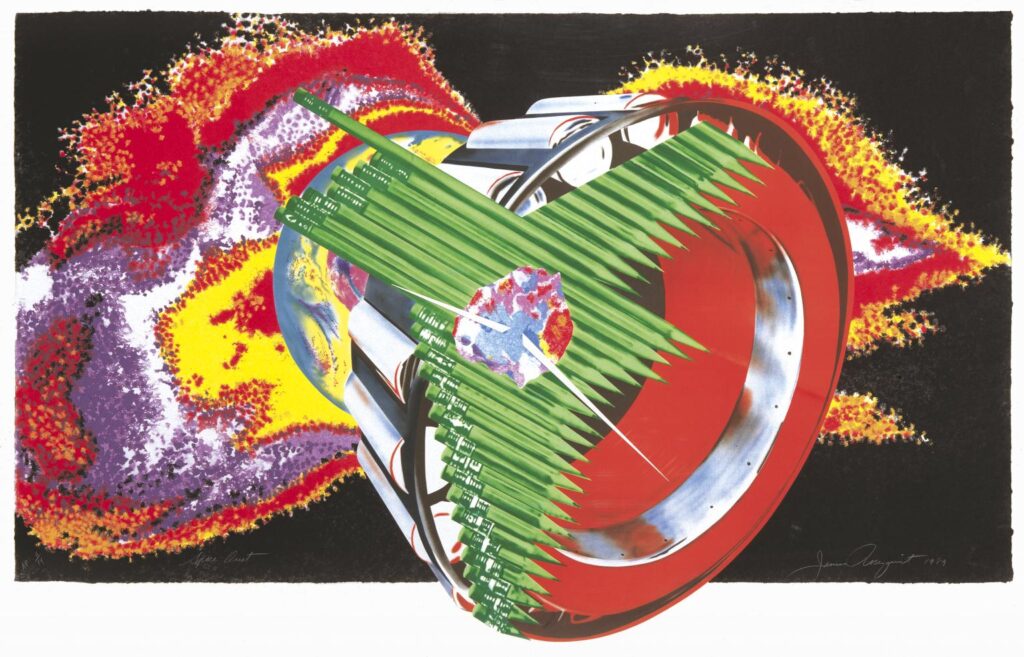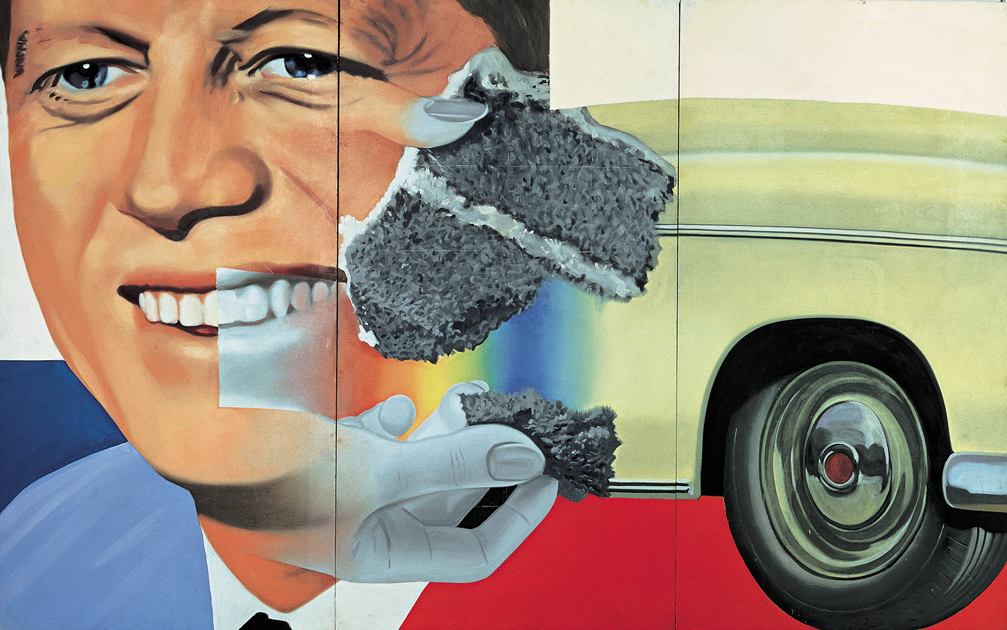Artists’ attitudes towards consumerism and the culture of mass media
The concept of consumerism arose from the economic, political, technological, and cultural context of late 19th and early 20th century capitalism. Since the industrial revolution, society began consuming at a much higher rate than before. The development of technology and cheap fossil energy brought and expanded the manufacture of a wide range of commercial products that led to mass consumption.
The idea was that the consumption of consumer goods was linked to the achievement of success.
During the 60s and 70s, consumerism denoted a social and economic order that promotes the acquisition of goods and services in an ever-increasing amount. The promise of a good life in terms of happiness, well-being, and success of individuals presumed that we always needed to have more. In a society that promoted this lifestyle of leisure and consumption, the dominant art movement of abstract expressionism was pop art, which immersed itself into the living experience, erasing the boundaries between fine art and mass production.
Pop art, which saw products as an inspiration, represented the modern consumer landscape by portraying still lives as representations of the good life. Pop artists started to create artworks talking about everyday lives and experiences about capitalism, the unlimited market, sex, spending money, having it all, and wanting even more. Common objects were taken out of context and scrutinized for their symbolic value. Incorporating various aspects of the mass culture like advertisements, comic books of industrial labeling, pop artists created kitschy combinations of commercialized and recognizable elements.
The pop art movement developed in diverse directions within different countries. While American pop art was more interested in blurring the boundaries between high art and low culture, pop art in the UK was much more critical towards consumer culture that was being exported across the continent.
In America, the post-era was marked by a period of prosperity. The country started to develop a consumer lifestyle while still recovering from the devastating results of WWII. During the 60s, industrialization had a big impact on America, which caused artists to either represent commercialization in their work or oppose it.
Advertising became a focus of many artists whose practice revolved around the critique of consumerism. Artists like Ron English introduced the concept of advertisement hijacking or culture jamming. This tactic exposes the background of corporate advertisement by hijacking the billboard in which altering mass media messages are used to create subversive and political statements.
James Rosenquist began his career as a billboard painter as well. In the 60s he started using images from advertising to comment on a world increasingly obsessed with products and celebrities. Typically using fragments of oversized products and faces, he hinted at the impact of consumer culture on the environmental balance of the planet. His series ‘Welcome To The Water Planet’ imagines what the earth looks like from above.


While consumerism in Europe was still undeveloped at that time, American artists were completely surrounded by mass-produced imagery and objects, completely trapped in the world of consumption. The subtle irony which followed the works of Andy Warhol and Roy Lichtenstein and the indirect criticism of social circumstances is what resulted in the ambivalent assessment of their attitude towards consumerism.
Consisting of 32 canvases, all looking the same yet depicting different variations of the soup, the artwork brings an entire cans shelf from the supermarket, presenting it as a piece of fine art. Warhol’s work is recognizable for his use of repetition with photographic silkscreen printing, which replicated the look of commercial advertising and allowed him to mass produce his works.
Among Lichtenstein’s many comic book based works, this work ‘Blonde Waiting’ is an example of a relatable image, one that someone instantly feels connected to due to its commonness, a girl waiting for her prince to call her. It doesn’t matter who the woman is because what is interesting is that her current state of mind matches those of many others in modern society.
Artists have always been intrigued by consumer culture and the way it shapes our society. Yet this relationship between art and the distribution and consumption of commodities has always been complicated. Artists who individually contributed to artistic movements such as abstract expressionism, pop art, minimalism, and performance art, expressed both positive and negative attitudes toward consumerism. Therefore there is a distinct differentiation between pro-consumerist and anti-consumerist attitudes of artists.
Pop artists who accepted consumerist culture were extremely successful as their art was a reflection of the world’s state at that time. People valued objects and representations of their own culture. Simultaneously, anti-consumerist artists and performance artists maintained the view that only the ineffable should be highly appreciated, as the superficial should be ultimately destroyed. These artists expressed their work through a minimalist mentality and methodology. Although their ideas were insightful and true, people tended to respect pop culture art more for its superficial quality and attainability.
On the one hand, artists like Roy Lichtenstein and Frank Stella aimed at mirroring the impersonality of mass culture, turning their work into objects, on the other, artists such as Robert Smithson, deliberately shunned consumerism, creating works that could not be bought, sold or commodified.
In response to industrial culture, Roy Lichtenstein focused on techniques of mass production and reproduction that he incorporated into his work. Through this media, he believed to be able to bridge art with modern life, which appeals to popular culture. In the 60s Lichtenstein based his work not on an actual object but on its reproduction in magazines and newspaper images, specifically focusing on cartoon-like images.
“One of the things a cartoon does is to express violent emotion and passion in a completely mechanical and removed style.”
For him the mediation of mass media made the image removed from reality, making the viewer focus on how he perceived the world through mass media. He painted impersonally intending to make his works look mechanically produced. With the use of the Ben Day dot pattern, he was able to reproduce a mass media technique from the reproduction of those images from magazines or comic books. He created drawings incorporating parts from comics and advertisements, combining them into a new and semi-innovative work of art. He would then stretch and enlarge the work and transfer it with an opaque projector to the canvas, after which he would fill in the dots.
Like most pop artists, Lichtenstein respected common everyday life and the urban environment and glorified objects related to mass media culture. This artwork ‘Hot Dog’ alludes to the American kitchen culture and is centered on food and the American obsession with consumption and food. The technique he employed positively mirrors our mass media culture, as he painted bigness and brightness that is important and industrial and stands for the actual world we live in. By simplifying these objects, the work now objectified hangs as though it is self-contained as it does not relate to the visual ground or have spatial context. Its meaning is straightforward and honest.
As already mentioned, Lichtenstein sought to paint artificially.
Alternatively, Frank Stella attacks the introspective motive in abstract expressionism. His painting is based on the fact that only what can be seen there is there. His works do not allude to sentiment, emotion, or symbolism, nor do they have any outside relationship or context. He eliminates all senses of foreground and background. Stella’s formation of an object is best seen through his shaped canvases which relate to sculpture and form of work, allowing optical movement across the canvas. Using this technique, he reveals and evokes the industrialization of the time.
Although many artists exploited the commercialization of that time, not all artists were pro-consumerism. Some artists approached the nature of minimalism, in which art is dependent on space and the viewer’s relationship with the space. A theatrical situation can be presented as if on stage to demand interaction between the object itself and the person moving within it. Minimalist art is concerned with the outside world and the self-awareness of the spectator. The works consist of a complex array of optical shapes which depend on the artist’s creativity.
Robert Smithson rejected art centered on human beings and their popular cultural desires and valued art as something which was experienced and not framed, very different from Lichtenstein or Stella.
Smithson formed crystalline structure geometric designs, which relate to mathematics and criticize traditional art. In formalist criticism, emphasis was placed on the physical qualities of a canvas as being rectangular and having a frame. Instead of a rectilinear canvas and frame, Smithson employed a neon mirror and crystalline structures. Within consumerist art, the goal of art is to reflect the state of the world, as seen in Lichtenstein’s and Stella’s work. Here Smithson is mirroring the world, instead of creating an illusion of reflection as paintings usually do. The mirrors mirror each other, art mirrors itself and the outside world, therefore art is ridiculing itself. Hereby Smithson aims at mocking the function of art and making fun of Stella’s shaped canvases which translate art into objects.
His work ‘Enantiomorphic chambers’ consists of crystalline compounds that have molecular structures that mirror each other, instead of mirroring the world, so that people standing before them see their reflections, presenting an illusion and causing the spectators to be imprisoned by the art. Smithson felt that through these mirrors he could help put an order in the world by allowing people to directly experience art. People would view themselves and recognize their decomposition through the distortions of the mirrors. This personal transience translates into the acknowledgment of the deterioration of all human beings, making them aware of the inevitable and steady deterioration of society.
Also, performance artists felt that artworks had to be experienced and not framed. In conflict with the mode of painting and sculpture, performance artists focused on time, body, and space and the relationship between themselves and the audience. Therefore their art is based on achieving spiritual and physical awareness and not exploiting subject matter, which would appeal to the instincts of mass media culture.
In the late 60s, artists attacked the commercialization of galleries, creating exhibitions as performances, which could not be bought or sold, as they were intangible and made spectators aware of their existence. Performance artists used their bodies as a medium as they felt their ideas would be better expressed through the use of the body. Nevertheless, the effectiveness of these performances was minimal as most modern day people were primarily attracted to the bigness and brightness of pop culture art.
References:
https://artsugar.co/blogs/news/artistic-responses-and-attitudes-towards-consumerism
https://www.widewalls.ch/magazine/consumerist-culture-art-10-artworks
https://www.widewalls.ch/magazine/consumerist-art-culture-critique
Leave a Reply